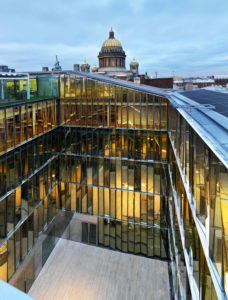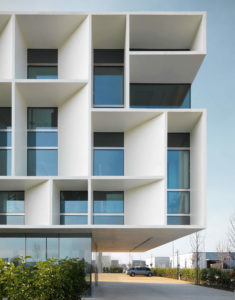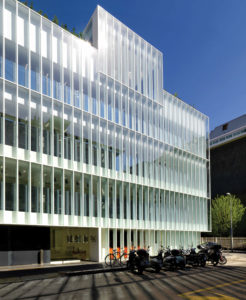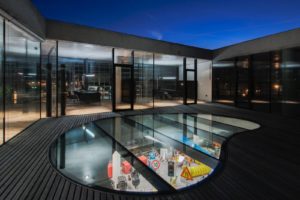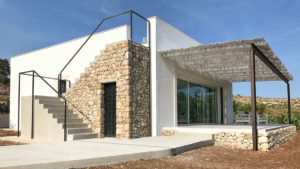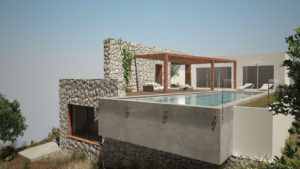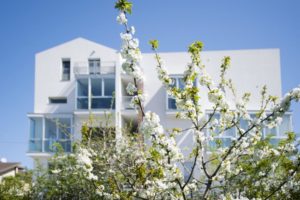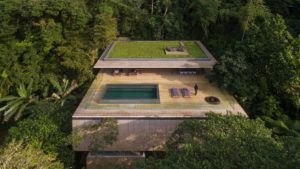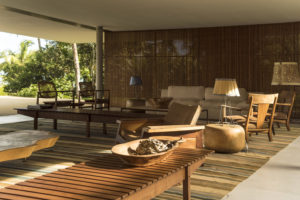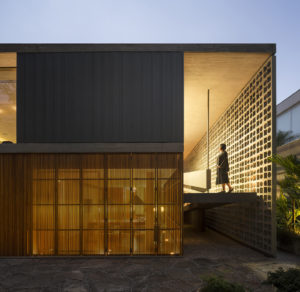Il Business Centre Quattro Corti si trova nel nucleo storico della città di San Pietroburgo, molto vicino alla cattedrale di Sant’Isacco. Il progetto prevede la realizzazione di un edificio moderno, mantenendo tuttavia le facciate storiche dei due edifici che occupavano in precedenza il sito. Nel volume così realizzato sono state scavate quattro corti per illuminare gli spazi interni, con funzione di luogo di incontro aperto a installazioni artistiche, mostre e altre attività pubbliche. Le facciate di queste corti sono composte di pannelli di vetro specchiante installati con diverse inclinazioni. Col variare dell’illuminazione nel corso della giornata le facciate si animano di riflessi, con un suggestivo effetto caleidoscopico. I vetri di ognuna delle corti hanno una colorazione diversa – oro, verde, azzurro, bianco – ispirata alla ricchezza cromatica delle architetture storiche di San Pietroburgo. Il complesso è destinato principalmente alla sede della società Gazprom Neft, ma ospita anche un ristorante all’ultimo piano.
Concorso ad inviti, primo premio
San Pietroburgo, Russia
2006 / 2010 – Costruito
Committente: Galaxy LLC
Superficie costruita: 23.500 sqm
© Andrea Martiradonna
La nuova sede amministrativa e operativa della società Bentini è costituita da un volume unitario e lineare arretrato rispetto al fronte stradale ed è stato progettato con standard qualitativi elevati, che uniscono alla grande flessibilità degli spazi interni un disegno di pianta semplice e ben organizzato sui vari livelli. Il fronte sul lato della strada conferisce un carattere distintivo e unico all’edificio, ed è realizzato sovrapponendo alla vetrata continua degli uffici una struttura a griglia modulare di filtri solari orientati, che ripartisce la facciata in vani rettangolari di varie dimensioni. Il lato posteriore dell’edificio è progettato per mantenere una continuità visuale forte con la campagna circostante attraverso una facciata totalmente vetrata. L’ultimo piano è stato pensato come uno spazio utilizzabile per eventi e convegni anche dalla popolazione residente, dando l’occasione di vivere lo spazio dell’azienda che si apre alla città che la ospita.
Faenza, RA, Italia
2009 / 2011 – Costruito
Committente: Bentini S.p.a.
Superficie costruita: 6.500 mq
© Andrea Martiradonna
La sede per uffici e showroom di Dolce & Gabbana a Milano rappresenta il risultato di un attento processo di consolidamento e recupero di due edifici adiacenti e collegati tra loro, uno dei quali risalente agli anni venti e l’altro agli anni sessanta. La facciata dell’edificio più recente è stata completamente rifatta e realizzata in vetro, segnata dal ritmo serrato degli elementi frangisole verticali in vetro opalino. Sviluppato su cinque piani e due interrati, il complesso ospita nella parte storica gli uffici e gli spazi di rappresentanza, mentre nell’edificio vetrato gli showroom si sviluppano a open space per tre piani, per chiudere all’ultimo con delle piccole terrazze ricavate dall’articolazione dei volumi del ristorante. Il progetto è basato su principi architettonici di grande rigore, con l’uso di materiali naturali come la pietra bianca Namibia, e materiali trasparenti e riflettenti, come il vetro e la lamiera d’acciaio lucida.
La sede per uffici e showroom di Dolce & Gabbana a Milano rappresenta il risultato di un attento processo di consolidamento e recupero di due edifici adiacenti e collegati tra loro, uno dei quali risalente agli anni venti e l’altro agli anni sessanta. La facciata dell’edificio più recente è stata completamente rifatta e realizzata in vetro, segnata dal ritmo serrato degli elementi frangisole verticali in vetro opalino. Sviluppato su cinque piani e due interrati, il complesso ospita nella parte storica gli uffici e gli spazi di rappresentanza, mentre nell’edificio vetrato gli showroom si sviluppano a open space per tre piani, per chiudere all’ultimo con delle piccole terrazze ricavate dall’articolazione dei volumi del ristorante. Il progetto è basato su principi architettonici di grande rigore, con l’uso di materiali naturali come la pietra bianca Namibia, e materiali trasparenti e riflettenti, come il vetro e la lamiera d’acciaio lucida.
© Andrea Martiradonna
© Matteo Piazza
© Alberto Piovano
© Ruy Teixeira
SLIDE SHOW
Milano, Italia
2005 / 2006 – Costruito
Committente: Dolce&Gabbana S.r.l.
Superficie costruita: 5.000 mq
© Andrea Martiradonna
© Matteo Piazza
© Alberto Piovano
© Ruy Teixeira
Nella nuova sede l’azienda di elettromeccanica Blaas presenterà la sua gamma di prodotti e offrirà assistenza ai propri clienti. Al piano terra dell’edificio vi è l’emporio vendita, al primo piano la sala esposizione e l’officina di riparazioni, infine al secondo piano gli uffici amministrativi. La costruzione manifesta nel suo insieme omogeneità e compattezza. Esiste comunque una separazione netta fra il settore aperto al pubblico e quello privato. Questa suddivisione chiara e formale dei diversi settori dell’edificio viene percepita dal cliente anche dall’esterno.
Cubatura edificio: 11.000 m³
Superficie totale: 1.250 m²
Costi di costruzione: 2,5 mil. Euro
The projects Blaas is the fruit of a special focus to the client’s needs, the context and the utilisation. For the Blaas project, a trading firm for the solid building, a contained architecture in fair faced concrete and glass gives maximum prominence and visibility to the displayed items.
progetto di ristrutturazione ed ridisegno di un immobile sito nel Comune di Avola (SR), in zona montana.
L’intervento pensato per la realizzazione di un’abitazione unifamiliare, ridisegna e ristruttura una villetta degli anni ’80, definendo una linea architettonico-stilistica di pregio anche grazie all’uso di materiali e tecniche costruttive locali declinate in un linguaggio ed un uso più contemporaneo.
L’anonimo e confuso volume edilizio originario viene innanzitutto depurato da sovrastrutture ed eccessi alla ricerca di una forma di base più “pulita” ed essenziale, poi l’uso della pietra arenaria di Siracusa, del ferro ossidato e del legno doverà a questo una nuova veste ed un carattere.
Al di là della creazione di uno spazio interno più confortevole e attento agli usi, al gusto e alle esigenze attuali, grande attenzione è data allo spazio esterno che in progetto può contare di un’ampia terrazza belvedere sottesa da un romantico pergolato, e di una zona barbecue ben ombreggiata ed accessoriata di griglia, forno a legna, piani di lavoro e sedute.
Completa il novero delle attrezzature esterne, l’area relax a servizio della camera padronale ed il giardino ricco di mandorli ed ulivi.
progetto di ristrutturazione ed ridisegno di un immobile sito nel Comune di Noto (SR), in zona panoramica con vista verso la costa.
L’intervento pensato per la realizzazione di un’abitazione unifamiliare, ridisegna e ristruttura un immobile “grezzo” su unico livello in corrispondenza di un importante salto di quota dovuto all’orografia del terreno.
L’intervento progettuale non è un semplice completamento dell’opera incompiuta, ma piuttosto un complesso progetto che mira a riformulare totalmente l’esistente realizzando una residenza unica dalle linee contemporanee ma con un marcato rimando alla tradizione ed al contesto in virtù delle scelte materiche, una villa impreziosita da piscina con vista panoramica che si affaccia come una balconata sul natural declivio, attrezzata all’intorno con una pergola in corten ed un’area barbecue ben schermata dall’imponente setto in pietra che al contempo garantisce maggiore privacy rispetto alle abitazioni circostaniti, a quest’interessante area esterna.
l progetto di questo edificio rientra nella sperimentazione tipologica di un modello insediativo di tipo residenziale. L’idea alla base del progetto è la ricerca di uno sviluppo distributivo in grado di restituire agli abitanti il più alto grado di privacy consentito da un’unità residenziale.
L’edificio è stato scomposto fisicamente in tre diverse unità, dove l’impressione è di “vivere in una casa isolata”. Le singole unità – separate tra loro e senza muri in comune – si ricompongono tramite il ballatoio di accesso in un unico architettonico: una sorta di organismo architettonico, articolato per giacitura e affaccio.
I prospetti, infatti, sono sempre diversi sia per la giacitura dell’edificio sia per la composizione tra vuoti e pieni, dove è visibile la forte differenziazione delle aree giorno – molto aperte sull’esterno attraverso grandi superfici vetrate, loggiati, balconi e bow-window – e le zone notte molto più intime.
Nell’immagine complessiva, l’edificio – pur nella sua pulizia geometrica e nel suo rigoroso colore bianco – presenta scorci sempre differenti e, in alcuni, richiama suggestioni mediterranee.
LOCATION ITALY – MONTESILVANO
DESIGNERS STUDIO ZERO85, GIOVANNA PIZZELLA, MIRKO GIARDINO, MARIO MICHETTI
PROJECT YEAR 2009
PHOTOS BY SERGIO CAMPLONE
The project is located on the paulista shore in the region of the Rain Forest and the land has a mountainous topography with dense vegetation. The introduction of this house to this landscape has the objective of optimizing the connection between architecture and nature, privileging the view looking out to the ocean and the incidence of sunlight in the internal spaces. Furthermore, the positioning of the house on the site obeyed the previously-open area in the vegetation.
The main volume of the house is elevated from the ground and seems built into the topography. The house, therefore, projects itself out from the mountain. The contact elements between the slope and the construction – as for example the wooden decks – were shaped to respect the existing land, thereby creating an organic interaction between nature and the architectural elements. In the part that it comes out of the mountain, the structure touches the ground with only two pillars.
The 3 floors of Jungle House create a clear programmatic division for the project: the ground floor houses a large covered wooden deck, connected to a small room for the children; on the first floor there are six bedrooms – five of them with small verandas with hammocks – and a tv room; the third and last floor is the social area of the house, including a swimming pool, a living room and the kitchen.
Thus, the architecture defined an inverted vertical organization of the program when compared to what is usually done in single-family houses: while the pool and the social areas are on the roof, the bedrooms are located on the floor below. The deck is on the ground floor- protected by the projection of the house – is an ample and generous space that configures a shaded shelter for the children to play. The utility rooms are also located on this story.
From the wooden deck on the ground floor starts the stairs to access the house volume that “interrupts” the concrete slab. Before entering the closed space, one passes an intermediary space, enveloped by concrete and which houses a luminous work by the artist Olafur Eliasson. The interiors project sought to create a modern atmosphere, offering a cozy feeling necessary to remain in this tropical environment.
The landscape recomposes the native species. When one is in the house, the relationship with the surrounding vegetation occurs not only through the view but also through the plants that surround the wooden decks. On the ground floor, you can stroll in the midst of trees; on the first floor, light enters filtered through the tree-tops; and on the roof, there is the vegetation with the ocean in the background.
The architecture of the house privileged the use of exposed concrete and wood, as much in the interior spaces as well as the exterior. The bedrooms have wooden sun-screens, small brises-soleil, mounted as folding doors that can be manipulated by the users according to the climactic needs.
In the Jungle House, the project began with a transversal cut which allowed for the positioning of the pool to be semi-built-in to the slab thereby not losing any area on the floor below. Furthermore, the infinity pool as well as the raised border relative to the height of the deck makes it such that the view and the landscape serve as an extension of the pool waterline. To lessen the height of the top floor and thus get an external proportion more horizontal to this volume, the floor in the living room was lowered by 27 cm relative to the external wooden deck.
This last floor offers a spatial sensation which synthesizes the principles of the house: on one side, there is a deck which houses the hot tub and the sauna – where there is an intense relation between the architecture and the mountain and its vegetation; on the other side, a ground fireplace and the pool; in the center – between these two free spaces – is the living room open to both sides and with cross-ventilation. This social space has a radical relation with nature, by means of both the view of the ocean as well as the proximity to the forest in the mountain.
The Txai House merges elements of the vernacular colorful Bahian Houses with the precise lines of Brazilian Modern architecture. Located in front of a beautiful beach in the city of Itacaré – in the Brazilian northeast – the site of Txai House reaches 13 meters above the sea level. This topographical condition allowed for, even with the existing treetops, a beautiful view of the coast.
To avoid excessive verticalization and still accommodate the entire necessity program, the house rests on two levels without any pavement overlapping. This solution ended up creating a new artificial configuration for the plot, as a second nature, which recomposes the original topography, now with the house settled.
On the lower floor, we have the living room. With a large veranda, all of the window frames can be entirely recessed. The living room then becomes an open space, protected by a large flat pre-stressed slab. The kitchen is joined to this social area, facing the dining room and contained within a wooden volume that also holds a small utility area and a washroom.
In front of the veranda-living-room, there is an infinity pool and a solarium with chaise-longs. In the back, a patio with vegetation ends up allowing for cross-ventilation in the area. The structural system was modulated in spans of 9.70m by 6.30m, in a rational domino system. On the roof of this first floor there is an open wooden deck with a wonderful view of the sea. On this second floor are also the bedrooms, located under the pitched roof in colorful wooden and stucco volumes.
There is no internal connection from the living room and the kitchen with the bedrooms. The trajectories therefore, are always done from the outside, with the garden as passage. The residents experience the climactic conditions while going from one to the other.
The bathrooms extend outside of the roof and are all opened to the outside, having their own individual gardens defined by walls, like patios. The doors in front of the rooms look out to a generous 2.5m-wide veranda where the hammocks rest on the recycled wood roof. The mashrabiya doors – a wooden latticed element, traditional in modern and colonial Brazilian architecture – shade the interior of the bedrooms, allowing the breeze to pass; and they can remain completely open for complete control of the interior light.
The materials used in the house are all local. Efforts were made to also have raw finishings that age well in the aggressive tropical coastal climate. In the case of the volumes, using a color chart inspired by the local houses, the architecture sought live and pure colors which, when applied on the wooden mashrabiya, contributes to the durability of the material in creating a thick layer of protection against the salt air.
The House Txai offers a radical experience of integration between the inside and out. It is a place to drink coconut water, swaying in the hammocks. The tropical atmosphere of Bahia impregnates all of the spaces and the contact with the garden is necessary in order to use the house, as it integrates the trajectories of quotidian life.
The arrival at House B+B – the access to the social area – is through an architectural trajectory, via an open ramp, located on the eastern side of the construction. This space is protected by hollowed-out concrete elements to the side, which create surprising effects of light and end up functioning as protection from bad weather conditions.
It is an interstitial space between the protected inside of the construction and the open garden. The ramp, long and smooth, extends the transition from interior to exterior creating the constant sensation of environ ment changing. This solution was vastly used by Brazilian modernism, which consecrated the radical use of ramps as a way of vertical circulation while reaffirming the Corbusian precepts of architectural promenade.
There is an intentional uncertainty about the character of this space: internal or external?
The reference to modernism lies also in the wall of hollowed-out elements, renowned from the 30’s in Brazil, as a solution to be reproduced on large scale, very appropriate for the tropical climate since it allows for shading without blocking of the fresh breeze.
The social area of the house creates a sensation of coziness and comfort, in an open space, without any structural interference for the organization of the furniture layout.
A 3.5m sliding door allows the kitchen to be completely integrated to the dining room. The counter used for food preparation is behind the window overlooking the ramp and receiving the ‘constructed’ light, filtered by the hollowed-out elements. Thus, the kitchen becomes a lit-up space and a pleasant ambient.
Different than the usual solution, the rooms are on the first floor – in direct relation to the garden – and can be also accessed internally via a staircase connected to the living room on the top floor. The wooden elements on this floor’s facade allow for the internal control of the sunlight and thus provides for a great thermal performance.
The use of ‘raw’ materials such as exposed concrete and wood give a lively aspect to residence, constantly changing over time. The architecture of B+B House sought to create a cozy, welcoming space, an intimate home as much for the daily lives of the residents as well as for the reception of friends in social gatherings.
